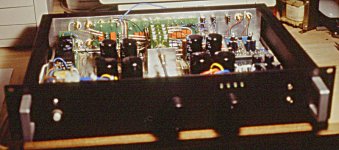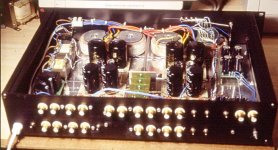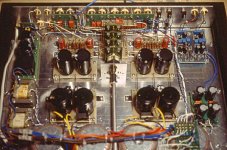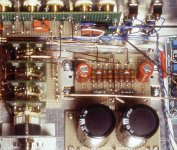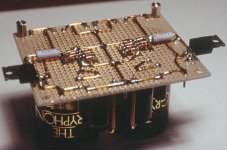jdev
welcome to x...
i hope i can answer few questions:
1a: dont know, i have not tested with aleph, but i think bosoz suites better to aleph
1: yes
2: yes you can take one
3:theoretical you should use the wattage of sum of the resistors, which you want to replace with one resistor
4:no -feel free to experiment (see postings before)
5:the bigger the cap, the better/lower the lower frequency range
6:theoreticaly there is lower noise, by using the pot at the output, but unfortunaly a stepped attenuator makes cracks on the speaker when switching. but there should be impedance problems when using in output as Henrik says. In future i will test it in the input
7:no
Ralf
welcome to x...
i hope i can answer few questions:
1a: dont know, i have not tested with aleph, but i think bosoz suites better to aleph
1: yes
2: yes you can take one
3:theoretical you should use the wattage of sum of the resistors, which you want to replace with one resistor
4:no -feel free to experiment (see postings before)
5:the bigger the cap, the better/lower the lower frequency range
6:theoreticaly there is lower noise, by using the pot at the output, but unfortunaly a stepped attenuator makes cracks on the speaker when switching. but there should be impedance problems when using in output as Henrik says. In future i will test it in the input
7:no
Ralf
Re: jdev
Thanx for answers Ralph, 1 last Q:
I am not clear on question 7.
1. Do I only take -In to ground?
2. Do I still need to utilise P102 - can I leave it out?
Thanx again .
Thanx for answers Ralph, 1 last Q:
ralf said:
"7. For unbalanced input - do I just take -In straight to ground, do I still need P102 here?"
7:no
Ralf
I am not clear on question 7.
1. Do I only take -In to ground?
2. Do I still need to utilise P102 - can I leave it out?
Thanx again .
jdev
1. yes
2.you don`t need p101
if you use XBosoz as unbalanced- balanced converter (as i do) you need a mono pot when pot is connected to input or a stereo-pot, when pot is at output. (of course per channel)
at input you use a 10k pot, at output you need a 5k pot.
Ralf
1. yes
2.you don`t need p101
if you use XBosoz as unbalanced- balanced converter (as i do) you need a mono pot when pot is connected to input or a stereo-pot, when pot is at output. (of course per channel)
at input you use a 10k pot, at output you need a 5k pot.
Ralf
Now I understand, thanx again.
Another question which I am not sure about, in BoSoZ there are C3 and C4, it is not on the circuit for XBoSoZ - are they now discarded?
What about their origenal purpose for filtering supply voltage?
Another question which I am not sure about, in BoSoZ there are C3 and C4, it is not on the circuit for XBoSoZ - are they now discarded?
What about their origenal purpose for filtering supply voltage?
JDeV
As i know Henrik forgot them to put in schematic.
c3 and c4 with 1000uF should be build in.
i build-in 2000uf`s which i had on hand,
Ralf
As i know Henrik forgot them to put in schematic.
c3 and c4 with 1000uF should be build in.
i build-in 2000uf`s which i had on hand,
Ralf
JDev
Last thing first, as Ralf just wrote, C3 an C4 should still be there, my fault, sorry.
1a. "Which will work better with Aleph30 - X'ed or normal BoSoZ?"
Try it, it is not difficult to swich between X and no X. I would say it would be better with X. I haven´t tried it, so why don´t You and then tell us?
3. "Must R117 now be 3Watt as well?"
1/4 - 1W will do for R116/117.
5. "C101,102 - must it be 33uf, will 10uf work? "
For the Aleph You just need 10uF, but if You are driving a more heavy load as my XSOZ You need 33uF.
6. "Do you now use P101, 102 for volume control - or do you use volume control on output?"
I have only tried a pot at the input. If You are driving the Aleph You can have a 5K pot at the output to also attenuate noise. But as Ralf said, it mig give some cracks at the speaker, I can´t explain why.
7. "For unbalanced input - do I just take -In straight to ground, do I still need P102 here?"
Need is a strong word, but the more identical the + and - input the better cancellation of noice and distortion. I tend to short the -input to ground at the terminals at the preamp, thus I will get differential noise and distortion cancellation on the potmeters (this requires P102) and wires inside the preamp, an also, as an alternative to short -In to ground, connect it to ground through a resistor matchig the singleended outputimpedance at the signalsource connected to +input if it is > 10K or so, Nelson mentioned taht in an other thread.
8. "The most difficult question - or most laughable - what is V1, V3 (AC 270m 0 Sine...)"
V1 and V3 is the signalsource, wich produces a ac signal with magnitude at 270mV and a sine wave with peaks at 270mV, all this for measuring.
Sproggit
"What would I have to change on the x-soz to drive headphones (Sennheiser HD 570's)? "
My version of the XBOSOZ is a nice headphone amp, but You need to rewire Your headphone, because You can´t connect it with common ground, You need 4 separate wires, 2 per ear. Driving them singleended would properly give You too much distortion.
Last thing first, as Ralf just wrote, C3 an C4 should still be there, my fault, sorry.
1a. "Which will work better with Aleph30 - X'ed or normal BoSoZ?"
Try it, it is not difficult to swich between X and no X. I would say it would be better with X. I haven´t tried it, so why don´t You and then tell us?
3. "Must R117 now be 3Watt as well?"
1/4 - 1W will do for R116/117.
5. "C101,102 - must it be 33uf, will 10uf work? "
For the Aleph You just need 10uF, but if You are driving a more heavy load as my XSOZ You need 33uF.
6. "Do you now use P101, 102 for volume control - or do you use volume control on output?"
I have only tried a pot at the input. If You are driving the Aleph You can have a 5K pot at the output to also attenuate noise. But as Ralf said, it mig give some cracks at the speaker, I can´t explain why.
7. "For unbalanced input - do I just take -In straight to ground, do I still need P102 here?"
Need is a strong word, but the more identical the + and - input the better cancellation of noice and distortion. I tend to short the -input to ground at the terminals at the preamp, thus I will get differential noise and distortion cancellation on the potmeters (this requires P102) and wires inside the preamp, an also, as an alternative to short -In to ground, connect it to ground through a resistor matchig the singleended outputimpedance at the signalsource connected to +input if it is > 10K or so, Nelson mentioned taht in an other thread.
8. "The most difficult question - or most laughable - what is V1, V3 (AC 270m 0 Sine...)"
V1 and V3 is the signalsource, wich produces a ac signal with magnitude at 270mV and a sine wave with peaks at 270mV, all this for measuring.
Sproggit
"What would I have to change on the x-soz to drive headphones (Sennheiser HD 570's)? "
My version of the XBOSOZ is a nice headphone amp, but You need to rewire Your headphone, because You can´t connect it with common ground, You need 4 separate wires, 2 per ear. Driving them singleended would properly give You too much distortion.
THANX
Thank you very much, Henrik and Ralf, for your replies. I am going to build the Bride both ways and will report back on how she behaved. 😉
P.S:
I just discovered this comment by Mr. Pass:
"Keep in mind that with a single input if you want exactly
the same output level on both polarities with BOSOZ,
then you want to current source the transistors from
the negative voltage rail with a real current source,
not just resistors.
On the other hand, the Aleph 5 doesn't care at all, so it
is adequate to simply ground the (-) input.
This only gets imprtant when you are using BOSOZ balanced
output to bridge a pair of amplifiers."
So since Aleph30 and Aleph5 are very similar in design I am not going to bother with the impedance matching part.
Thank you very much, Henrik and Ralf, for your replies. I am going to build the Bride both ways and will report back on how she behaved. 😉
P.S:
I just discovered this comment by Mr. Pass:
"Keep in mind that with a single input if you want exactly
the same output level on both polarities with BOSOZ,
then you want to current source the transistors from
the negative voltage rail with a real current source,
not just resistors.
On the other hand, the Aleph 5 doesn't care at all, so it
is adequate to simply ground the (-) input.
This only gets imprtant when you are using BOSOZ balanced
output to bridge a pair of amplifiers."
So since Aleph30 and Aleph5 are very similar in design I am not going to bother with the impedance matching part.
Re: THANX
...that would be nice of you,
Ralf
JDeV said:I am going to build the Bride both ways and will report back on how she behaved. 😉
...that would be nice of you,
Ralf
Waiting for some news from your various experiments, I have thought about my BOSOZ and its output gain and distortion. If we reduce the output voltage gain, we get the lower distortion. Therefore, if I manage to reduce the gain down to the rock bottom, I could get the best result for my audio system. Great...
I have started digging into. I have altered four different gain levels: 11dB, 6dB, 3.5dB and 0dB. With 11dB-gain, I played the soundtrack to The Lord of The Rings on my DVD player for about 203 minutes, and with 6dB-gain for another 203 minutes, and with 3.5dB-gain for another 203 minutes, and with 0dB-gain for another 203 minutes, and back to 3.5dB-gain... On the course, I have opened and cleaned up my ears to sense every bit of differentiation of the distortions.
Damn it! I have forgotten the fact that my horn speakers have 8ohm-97dB. I have forgotten that the sounds have been already too loud even before the reach to the 1V-output of BOSOZ, and it means that all tweaks and tests have been done inside the 1V-output signal level. I should have remembered that my ears have no ability to distinguish any difference of the distortion at less than 1V of output signals. Hearing the difference of the distortion could have been possible only when the sound really roars so that the speaker horns tremble like mad beasts.
Anyhow, I have had a fun by doing something, and I have fixed it at the 3dB-gain simply because with the 3dB-gain and at the indication of volume knob almost to the upper end, the sound is loud enough at the level just below my own boiling point.
Waiting for some news from your various experiments...
I have started digging into. I have altered four different gain levels: 11dB, 6dB, 3.5dB and 0dB. With 11dB-gain, I played the soundtrack to The Lord of The Rings on my DVD player for about 203 minutes, and with 6dB-gain for another 203 minutes, and with 3.5dB-gain for another 203 minutes, and with 0dB-gain for another 203 minutes, and back to 3.5dB-gain... On the course, I have opened and cleaned up my ears to sense every bit of differentiation of the distortions.
Damn it! I have forgotten the fact that my horn speakers have 8ohm-97dB. I have forgotten that the sounds have been already too loud even before the reach to the 1V-output of BOSOZ, and it means that all tweaks and tests have been done inside the 1V-output signal level. I should have remembered that my ears have no ability to distinguish any difference of the distortion at less than 1V of output signals. Hearing the difference of the distortion could have been possible only when the sound really roars so that the speaker horns tremble like mad beasts.
Anyhow, I have had a fun by doing something, and I have fixed it at the 3dB-gain simply because with the 3dB-gain and at the indication of volume knob almost to the upper end, the sound is loud enough at the level just below my own boiling point.
Waiting for some news from your various experiments...
jh6you, no more waiting for now!
Hi all, I have just changed my test-XBOSOZ into a new and better XBSOZ, made with better parts in the X-feedback, some new circiut layout and new type of wire.
The sound is verry different from my testsetup, and my problem is, I really don´t know if it´s the new parts, the layout or the new type of wires that causes this change, so this will not bring any "scientific" conclusions on what really makes the differences.
I will come back later with some description of my impressions from my listening, but since the Blackgate type N need more than 50 hours idleing, so I wil give the at least 100 hours before I will make the final jugement.
Meanwhile, I will send some pictures, darawings and the full scematic.
I have tried to attach pictures to this post, but my computer crasches every time, I will send the pictures separately.
Hi all, I have just changed my test-XBOSOZ into a new and better XBSOZ, made with better parts in the X-feedback, some new circiut layout and new type of wire.
The sound is verry different from my testsetup, and my problem is, I really don´t know if it´s the new parts, the layout or the new type of wires that causes this change, so this will not bring any "scientific" conclusions on what really makes the differences.
I will come back later with some description of my impressions from my listening, but since the Blackgate type N need more than 50 hours idleing, so I wil give the at least 100 hours before I will make the final jugement.
Meanwhile, I will send some pictures, darawings and the full scematic.
I have tried to attach pictures to this post, but my computer crasches every time, I will send the pictures separately.
Scematic on this page: http://www.diyaudio.com/forums/showthread.php?threadid=3949&perpage=15&pagenumber=17
Attachments
- Home
- Amplifiers
- Pass Labs
- x soz
